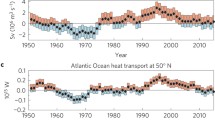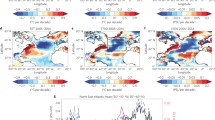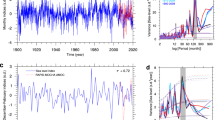Abstract.
The North Atlantic Oscillation (NAO) is the most important mode of variability in the northern hemisphere (NH) atmospheric circulation. Put simply, the NAO measures the strength of the westerly winds blowing across the North Atlantic Ocean between 40°N and 60°N. The NAO is not a regional, North Atlantic phenomenon, however, but rather is hemispheric in extent. Based on 60 years of data from 1935 to 1995, Hurrell (1996) estimates that the NAO accounts for 31% of the variance in hemispheric winter surface air temperature north of 20°N. The present article provides an overview of the NAO, its role in the atmospheric circulation, its close relationship to the Arctic Oscillation of Thompson and Wallace (1998), and its influence on the underlying North Atlantic Ocean. Some discussion is also given on the dynamics of the NAO, the possible role of ocean surface temperature, and recent evidence that the stratosphere plays an important role in modulating the NAO.
Similar content being viewed by others
Author information
Authors and Affiliations
Rights and permissions
About this article
Cite this article
Greatbatch, R. The North Atlantic Oscillation. Stochastic Environmental Research and Risk Assessment 14, 213–242 (2000). https://doi.org/10.1007/s004770000047
Issue Date:
DOI: https://doi.org/10.1007/s004770000047




